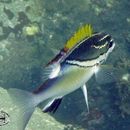Diagnostic Description
provided by Fishbase
This species is distinguished by the following characters: head scales reaching to or just in front of anterior nostrils; lateral line scales 43-47 (usually 45-46); pectoral fin rays 16-18 (usually 17); snout length less than eye diameter; greatest body depth 2.5-3.0 in SL. Colour dark grey on head and back with diagonal black-edged white band separating dark area from the rest of the mainly whitish body; white blotch below posterior dorsal fin; 3 yellow stripes on upper head; juveniles with alternating black and yellow stripes on the upper half and whitish below, Batesian mimic of the poison-fanged blenny Meiacanthus grammistes (Ref. 90102).
Morphology
provided by Fishbase
Dorsal spines (total): 10; Dorsal soft rays (total): 9; Analspines: 3; Analsoft rays: 7
Trophic Strategy
provided by Fishbase
Occur inshore (Ref. 75154). Found in small aggregations. Juveniles appear to be Batesian mimics of poison-fanged blenniids (Meiacanthus).
Biology
provided by Fishbase
Common on coral reefs. Adults occur on most reef habitats, usually in pairs, and juveniles inshore or in lagoons or rubble zones (Ref. 48635). Occurs singly or in small aggregations. Feeds on small fishes and benthic invertebrates. A protogynous hermaphrodite (Ref. 9785). Juvenile mimics poison-danged blenny Miacanthus grammistes, Batesian mimic (Ref. 90102). Caught mainly by handline and live specimens captured by hand net for the aquarium export trade; no major fishery exists (Ref. 9785). It is parasitised by the monogenean Anoplodiscus hutsonae on the pectoral fins and body surface (Ref. 124057).
- Recorder
- Kent E. Carpenter
Importance
provided by Fishbase
fisheries: subsistence fisheries; aquarium: commercial
- Recorder
- Kent E. Carpenter
分布
provided by The Fish Database of Taiwan
分布於印度-西太平洋區,西起印尼,東至萬那杜,北至日本南部,南至澳洲及新加勒多尼亞皆有分布。台灣各海域皆可發現。
利用
provided by The Fish Database of Taiwan
本魚全年皆有產,可利用手釣或在礁岩外砂地放流刺網捕獲,唯因其多單獨活動,故捕獲數量通常不多。體色豔麗,常被飼養於水族箱內。
描述
provided by The Fish Database of Taiwan
體長橢圓形,側扁;頭端尖細,頭背幾成直線,兩眼間隔區不隆突。吻中大。眼大;眶下骨的後上角具一銳棘,下緣有細鋸齒,上緣具前向棘。口中大,端位;上頜末端上緣不具鋸齒狀;頜齒細小,帶狀;鋤骨、腭骨及舌面均不具齒。第一鰓弓下枝鰓耙數5-7。體被大櫛鱗;頭部鱗域向前伸展至前鼻孔;側線鱗數45-46;側線與硬背鰭基底中點間有鱗3
.5。背鰭連續而無深刻,具硬棘
X,軟條9;臀鰭硬棘III,軟條
7;腹鰭達臀鰭起點;胸鰭達肛門;尾鰭上下葉不呈絲狀延長。成魚體黃綠色或灰褐色,腹面銀白色,體側有一雙邊鑲黑邊之白色斜帶,自眼下斜行至背鰭第X棘及第1軟條間之基底處,另有一黃線自側線起點以迄第V背鰭棘基底,背鰭後方若干軟條之基部有一白色大斑。背鰭軟條部前部上緣、臀鰭前部及尾鰭上下緣深紅或黑色。幼魚體具3條黑縱線,縱線間為黃色,背鰭軟條部前部上緣、臀鰭前部及尾鰭上下緣黑色。
棲地
provided by The Fish Database of Taiwan
通常單獨或數尾在礁岩地區或礁岩外緣之砂地上活動,游泳時以一游一停的方式前進,以礁岩或砂地上的小魚、蝦或軟體動物為主食。
Two-lined monocle bream
provided by wikipedia EN
The two-lined monocle bream (Scolopsis bilineata) is a species of threadfin bream native to the Indian Ocean and the western Pacific Ocean. An inhabitant of coral reefs, this species can be found at depths from 1 to 25 m (3.3 to 82.0 ft). They are carnivorous, preying on smaller fishes, as well as benthic invertebrates. This species can reach a length of 25 cm (9.8 in), though most only reach a length of around 13 cm (5.1 in). This species is sought-after by local peoples for food and can also be found in the aquarium trade.[1]
The two-lined monocle bream exhibits biofluorescence, that is, when illuminated by blue or ultraviolet light, it re-emits it as green, and appears differently than under white light illumination (only stripes on the upper front part are visible). Biofluorescence may assist in intraspecific communication and camouflage, blending the fish with green-fluorescing Acropora corals.[2]
References

- license
- cc-by-sa-3.0
- copyright
- Wikipedia authors and editors
Two-lined monocle bream: Brief Summary
provided by wikipedia EN
The two-lined monocle bream (Scolopsis bilineata) is a species of threadfin bream native to the Indian Ocean and the western Pacific Ocean. An inhabitant of coral reefs, this species can be found at depths from 1 to 25 m (3.3 to 82.0 ft). They are carnivorous, preying on smaller fishes, as well as benthic invertebrates. This species can reach a length of 25 cm (9.8 in), though most only reach a length of around 13 cm (5.1 in). This species is sought-after by local peoples for food and can also be found in the aquarium trade.
The two-lined monocle bream exhibits biofluorescence, that is, when illuminated by blue or ultraviolet light, it re-emits it as green, and appears differently than under white light illumination (only stripes on the upper front part are visible). Biofluorescence may assist in intraspecific communication and camouflage, blending the fish with green-fluorescing Acropora corals.
- license
- cc-by-sa-3.0
- copyright
- Wikipedia authors and editors

